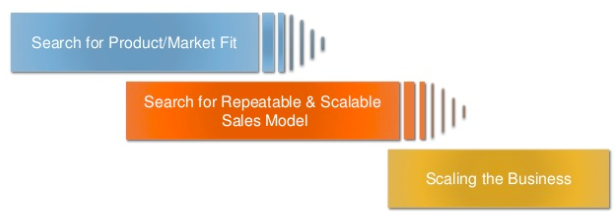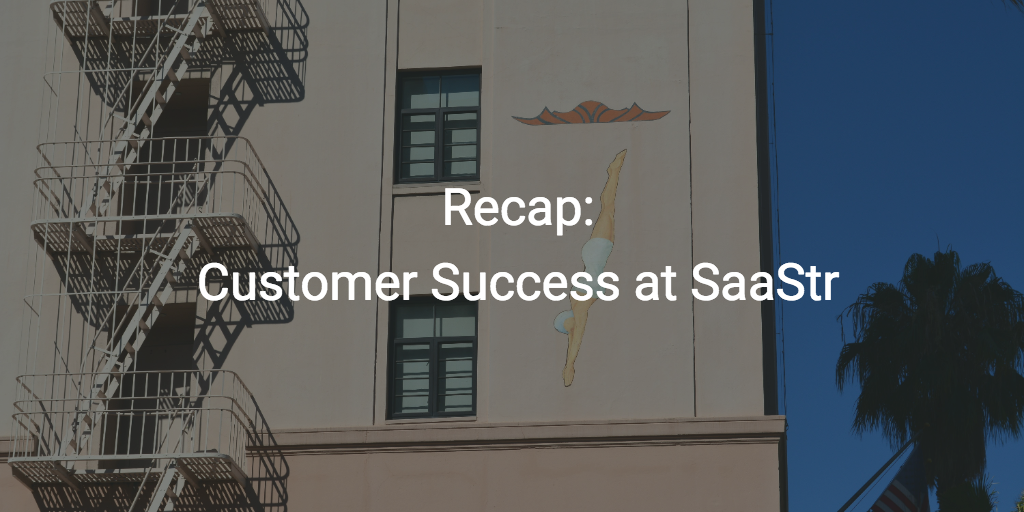I had a great time at SaaStr this week.
I hosted a panel on “How to Take Customer Success from Idea to Action” with three incredible customer success leaders: Ashley Fryar (VP of Customer Success at NAVEX Global), Bernie Kassar (Chief Customer Officer at Xactly), and Mary Poppen (Chief Customer Officer at Glint). In case you missed it, here were the takeaways.

To set the context for the discussion, we referred to a framework, created by David Skok of Matrix Partners, to describe the life of a startup, with three stages:
- Stage 1: The Search for Product-Market Fit
- Stage 2: The Search for a Repeatable Growth Model
- Stage 3: Scaling the Business

In my mind, the stages of customer success for a SaaS product directly mirror those.
- In Stage 1, we’re figuring out the “whole product,” which inevitably includes not just product features but also human intervention. Very few products deliver value 100% “out of the box”—help from a person is required. That’s where customer success comes in.
- In Stage 2, we’re figuring out what’s the right model for customer success in my business.
- In Stage 3, we’re executing that model at scale.
Here’s the panel’s guidance on how to tackle each of those stages:
Stage 1: “Figuring Out Your Whole Product”
- Hire Customer Success Managers that complement your product. Bernie talked about how his CSMs at Xactly are focused on training (to drive adoption) because they can rely on a professional services team or a system integrator to handle the initial implementation, whereas his former team at Mixpanel was technical and product savvy since their focus was onboarding and ongoing adoption. If your product has gaps, hire technical CSMs who can create hacks to fill those gaps and then communicate feedback to your Product team; I like to call that role “CSM of the gaps.”
- Hire a VP who complements your product. Mary explained that if the product doesn’t obviously communicate value to an executive at your client, you’ll need a VP who can align with that exec and explain the value.
- If you have multiple products, you’ll need CSMs who can serve as quarterbacks for your clients to help them navigate through the maze of your company. Ashley talked about how NAVEX’s series of acquisitions motivated her and the company to create a Customer Success team to help clients work more smoothly with their business and to cross-sell products into white space in the combined client base.
Stage 2: “Finding the Right Model”
- Create a thorough process for diagnosing churn. Avoid the temptation to sweep churn under the carpet by pointing to “uncontrollable factors” (which are often cited to be sponsor change, client pivot, or loss to a competitor). Churn can always teach you how to execute better. Mary talked about the importance of sharing those learnings across your company, so that each department can act on the feedback. Improving gross retention takes a village.
- Pause before abandoning your SMBs. If you have churn in your small business segment, don’t skip to the conclusion that your should abandon that segment and “move upmarket.” I’ve seen teams improve their gross retention rate in their small business segment by 20 percentage points by investing at the right levels and improving execution.
- Invest appropriately in Customer Success. Studies show that SaaS companies invest between 10 and 15 cents per dollar of renewal, depending on the year of the survey. You should see the impact of this investment on metrics such as gross retention, net retention, NPS, and adoption. You can justify investing more in customer success to your CFO by taking on a higher gross retention target, and funding the headcount from that GRR improvement.
Stage 3: “Executing at Scale”
- Services help your software business. Founders of SaaS companies often shudder at the idea of selling services. (“After all, I’m a software person!”) But services can help you cover the cost of offering your clients much needed help from your team—and thereby boost your subscription metrics. Ashley shared that her Finance teams did an analysis that showed that net retention improved dramatically when a client purchased services. Use the metric Attach Rate (dollars of services bookings per dollar of subscription bookings) and refer to industry benchmarks to assess whether you’re selling the right amount of services.
- Reduce effort in your product. Even as we’re taking for granted that clients often need help from people, invest in reducing the effort that your product requires (from your clients and your own team) to generate value. Create systems between your Product team and your Customer Success team, such as shared adoption metrics. Bernie also discussed the importance of defining processes for how Product and CS should work together to automate more.
We ended with the age-old question, “Who should own renewals, Sales or Customer Success?” Bernie and Mary advocated for Customer Success, but Ashley responded, “No comment”—further proof that we’ll never come to consensus. We’ll try again at the Pulse conference in May!

